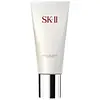What's inside
What's inside
 Key Ingredients
Key Ingredients

 Benefits
Benefits

 Concerns
Concerns

 Ingredients Side-by-side
Ingredients Side-by-side

Cocamidopropyl Hydroxysultaine
CleansingSodium Cocoyl Sarcosinate
CleansingCoco-Betaine
CleansingSodium Laureth Sulfate
CleansingSodium Chloride
MaskingAloe Barbadensis Leaf Extract
EmollientAvena Sativa Kernel Extract
AbrasiveAlgae Extract
EmollientSesamum Indicum Seed Oil
EmollientMedicago Sativa Seed Powder
Skin ConditioningHelianthus Annuus Seedcake
AbrasivePrunus Amygdalus Dulcis Seed Meal
AbrasiveEucalyptus Globulus Leaf Oil
PerfumingSodium Gluconate
Skin ConditioningCopper Gluconate
Skin ConditioningCalcium Gluconate
HumectantMagnesium Gluconate
Skin ConditioningZinc Gluconate
Skin ConditioningTocopheryl Succinate
AntioxidantNiacin
SmoothingSesamum Indicum Seed Powder
Skin ConditioningButylene Glycol
HumectantSucrose
HumectantCaprylyl Glycol
EmollientSodium Bicarbonate
AbrasiveTourmaline
Hexylene Glycol
EmulsifyingParfum
MaskingEDTA
Disodium EDTA
Methylchloroisothiazolinone
PreservativeMethylisothiazolinone
PreservativePhenoxyethanol
PreservativeAlpha-Isomethyl Ionone
PerfumingGeraniol
PerfumingButylphenyl Methylpropional
PerfumingLinalool
PerfumingCI 61570
Cosmetic ColorantCI 19140
Cosmetic ColorantCocamidopropyl Hydroxysultaine, Sodium Cocoyl Sarcosinate, Coco-Betaine, Sodium Laureth Sulfate, Sodium Chloride, Aloe Barbadensis Leaf Extract, Avena Sativa Kernel Extract, Algae Extract, Sesamum Indicum Seed Oil, Medicago Sativa Seed Powder, Helianthus Annuus Seedcake, Prunus Amygdalus Dulcis Seed Meal, Eucalyptus Globulus Leaf Oil, Sodium Gluconate, Copper Gluconate, Calcium Gluconate, Magnesium Gluconate, Zinc Gluconate, Tocopheryl Succinate, Niacin, Sesamum Indicum Seed Powder, Butylene Glycol, Sucrose, Caprylyl Glycol, Sodium Bicarbonate, Tourmaline, Hexylene Glycol, Parfum, EDTA, Disodium EDTA, Methylchloroisothiazolinone, Methylisothiazolinone, Phenoxyethanol, Alpha-Isomethyl Ionone, Geraniol, Butylphenyl Methylpropional, Linalool, CI 61570, CI 19140
Water
Skin ConditioningGalactomyces Ferment Filtrate
HumectantButylene Glycol
HumectantPolysorbate 20
EmulsifyingGlycerin
HumectantSodium Hyaluronate
HumectantPEG-150
HumectantCellulose Gum
Emulsion StabilisingDisodium EDTA
Citric Acid
BufferingSalicylic Acid
MaskingLactic Acid
BufferingMalic Acid
BufferingSodium Citrate
BufferingSodium Benzoate
MaskingMethylparaben
PreservativeIllite Extract
Skin Conditioning
 Reviews
Reviews

Ingredients Explained
These ingredients are found in both products.
Ingredients higher up in an ingredient list are typically present in a larger amount.
Butylene Glycol (or BG) is used within cosmetic products for a few different reasons:
Overall, Butylene Glycol is a safe and well-rounded ingredient that works well with other ingredients.
Though this ingredient works well with most skin types, some people with sensitive skin may experience a reaction such as allergic rashes, closed comedones, or itchiness.
Learn more about Butylene GlycolDisodium EDTA plays a role in making products more stable by aiding other preservatives.
It is a chelating agent, meaning it neutralizes metal ions that may be found in a product.
Disodium EDTA is a salt of edetic acid and is found to be safe in cosmetic ingredients.
Learn more about Disodium EDTA